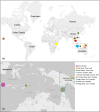Genome-wide SNPs of vegetable leafminer, Liriomyza sativae: Insights into the recent Australian invasion
- PMID: 35899255
- PMCID: PMC9309458
- DOI: 10.1111/eva.13430
Genome-wide SNPs of vegetable leafminer, Liriomyza sativae: Insights into the recent Australian invasion
Abstract
Liriomyza sativae, the vegetable leafminer, is an important agricultural pest originally from the Americas, which has now colonized all continents except Antarctica. In 2015, L. sativae arrived on the Australian mainland and established on the Cape York Peninsula in the northeast of the country near the Torres Strait, which provides a possible pathway for pests to enter Australia and evade biosecurity efforts. Here, we assessed genetic variation in L. sativae based on genome-wide single nucleotide polymorphisms (SNPs) generated by double digest restriction-site-associated DNA sequencing (ddRAD-seq), aiming to uncover the potential origin(s) of this pest in Australia and contribute to reconstructing its global invasion history. Our fineRADstructure results and principal component analysis suggest Australian mainland populations were genetically close to populations from the Torres Strait, whereas populations from Asia, Africa, and Papua New Guinea (PNG) were more distantly related. Hawaiian populations were genetically distinct from all other populations of L. sativae included in our study. Admixture analyses further revealed that L. sativae from the Torres Strait may have genetic variation originating from multiple sources including Indonesia and PNG, and which has now spread to the Australian mainland. The L. sativae lineages from Asia and Africa appear closely related. Isolation-by-distance (IBD) was found at a broad global scale, but not within small regions, suggesting that human-mediated factors likely contribute to the local spread of this pest. Overall, our findings suggest that an exotic Liriomyza pest invaded Australia through the Indo-Papuan conduit, highlighting the importance of biosecurity programs aimed at restricting the movement of pests and diseases through this corridor.
Keywords: biological invasions; ddRAD; gene flow; genome‐wide SNPs; leafminers; population genetics.
© 2022 The Authors. Evolutionary Applications published by John Wiley & Sons Ltd.
Conflict of interest statement
None declared.
Figures





Similar articles
-
DNA-based identifications reveal multiple introductions of the vegetable leafminer Liriomyza sativae (Diptera: Agromyzidae) into the Torres Strait Islands and Papua New Guinea.Bull Entomol Res. 2015 Oct;105(5):533-44. doi: 10.1017/S0007485315000383. Epub 2015 May 20. Bull Entomol Res. 2015. PMID: 25991411
-
A molecular method for biomonitoring of an exotic plant-pest: Leafmining for environmental DNA.Mol Ecol. 2021 Oct;30(19):4913-4925. doi: 10.1111/mec.16092. Epub 2021 Sep 13. Mol Ecol. 2021. PMID: 34309946
-
Pest categorisation of Liriomyza sativae.EFSA J. 2020 Mar 9;18(3):e06037. doi: 10.2903/j.efsa.2020.6037. eCollection 2020 Mar. EFSA J. 2020. PMID: 32874253 Free PMC article.
-
Development of an agroinfiltration-based transient hairpin RNA expression system in pak choi leaves (Brassica rapa ssp. chinensis) for RNA interference against Liriomyza sativae.Pestic Biochem Physiol. 2024 Sep;204:106091. doi: 10.1016/j.pestbp.2024.106091. Epub 2024 Aug 19. Pestic Biochem Physiol. 2024. PMID: 39277418
-
Ten years of the Tiger: Aedes albopictus presence in Australia since its discovery in the Torres Strait in 2005.One Health. 2016 Feb 24;2:19-24. doi: 10.1016/j.onehlt.2016.02.001. eCollection 2016 Dec. One Health. 2016. PMID: 28616473 Free PMC article. Review.
Cited by
-
Populations of the Australian Saltmarsh Mosquito Aedes vigilax Vary Between Panmixia and Temporally Stable Local Genetic Structure.Evol Appl. 2025 Jun 23;18(6):e70119. doi: 10.1111/eva.70119. eCollection 2025 Jun. Evol Appl. 2025. PMID: 40557244 Free PMC article.
References
-
- Alaei Verki, S. T. , Iranipour, S. , & Karimzadeh, R. (2020). Vegetable leafminer, Liriomyza sativae (Diptera: Agromyzidae) damage mediated yield loss of cucumber. North‐Western Journal of Zoology, 16(2), 134–140.
-
- Andersen, A. , Nordhus, E. , Thanq, V. T. , An, T. T. T. , Hung, H. Q. , & Hofsvanq, T. (2002). Polyphagous Liriomyza species (Diptera: Agromyzidae) in vegetables in Vietnam. Tropical Agriculture, 79(4), 241–246.
-
- Anderson, C. D. , Epperson, B. K. , Fortin, M. J. , Holderegger, R. , James, P. M. , Rosenberg, M. S. , Scribner, K. T. , & Spear, S. (2010). Considering spatial and temporal scale in landscape‐genetic studies of gene flow. Molecular Ecology, 19(17), 3565–3575. - PubMed
LinkOut - more resources
Full Text Sources
Research Materials

